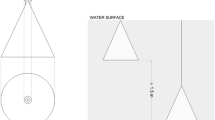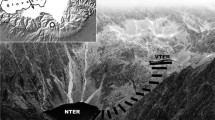Abstract
Emergence traps were used to sample insects along a transect through a river delta wetland on Green Bay, Lake Michigan in an attempt to document spatial and temporal patterns in insect emergence. Various abiotic factors were also measured to determine which factors influenced these dynamics. Significant decreasing gradients in dissolved oxygen and pH with distance from the river, coupled with trends in sum nitrate (nitrate + nitrite), revealed that riverine water was mixing with wetland water up to 100 m from the wetland-river interface. Annual emerging insect densities decreased exponentially with distance from the river while emerging insect biomass decreased linearly with distance, both of which were significant. Insects were largely comprised of Chironomidae, which represented 7–88% of the insects emerging. Loss of biomass was largely due to emergence of Aeshnidae (0–34%), Libellulidae (0–69%), Coenagrionidae (0–23%), Siphlonuridae (0–63%), and Chironomidae (1–25%). Major Chironomidae emergence events occurred from early spring until early summer and again from late summer to early fall. These events were likely an important source of energy needed for avian egg production, duckling growth, or migratory flights. Spatial and temporal patterns revealed the importance of wetland areas adjacent to the Peshtigo River to emerging insects, as well as to the transient organisms that use them as a food source.
Similar content being viewed by others
Literature Cited
APHA. 1992. Standard Methods for the Examination of Water and Wastewater, 19th Edition. American Public Health Association, Washington DC, USA.
Batzer, D. P. 1998. Trophic interactions among detritus, benthic midges, and predatory fish in a freshwater marsh. Ecology 79:1688–1698.
Becker, G. C. 1983. Fishes of Wisconsin. University of Wisconsin Press, Madison, WI, USA.
Beletsky, L. D. and G. H. Orians. 1996. Red-Winged Blackbirds: Decision-Making and Reproductive Success. The University of Chicago Press, Chicago, IL, USA.
Benke, A. C., A. D. Huryn, L. A. Smock, and J. B. Wallace. 1999. Length-mass relationships for freshwater macroinvertebrates in North America with particular reference to the southeastern United States. Journal of the North American Benthological Society 18:308–343.
Botts, P. S. 1999. Lake Erie coastal wetlands: a review and case study of Presque Isle invertebrates. p. 995–1012. In D. P. Batzer, R. B. Rader, and S. A. Wissinger (eds.) Invertebrates in Freshwater Wetlands of North America. John Wiley and Sons, New York, NY, USA.
Burton, T. M., C. A. Stricker, and D. G. Uzarki. 2003. Effects of plant community composition and exposure to wave action wave action on invertebrate habitat use of Lake Huron coastal wetlands. Lakes and Reservoirs: Research and Management 7:255–269.
Cardinale, B. J., T. M. Burton, and V. J. Brady. 1997. The community dynamics of midge larvae across the pelagic-littoral interface: do animals respond to changes in the abiotic environment? Canadian Journal of Fisheries and Aquatic Sciences 54:2314–2322.
Carpenter, J. H. 1965. The Chesapeake Bay Institute technique for the Winkler dissolved oxygen method. Limnology and Oceanography 10:141–143.
Courtney, G. W., R. W. Merritt, H. J. Teskey, and B. A. Foote. 1996. Aquatic Diptera: Part One. Larvae of Aquatic Diptera. p. 484–548. In R. W. Merritt and K. W. Cummins (eds.) An Introduction to the Aquatic Insects of North America, 3rd edition. Kendall/Hunt, Dubuque, IA, USA.
Davies, I. J. 1984. Sampling aquatic insect emergence. p. 161–227. In J. A. Downing and F. H. Rigler (eds.) A Manual for the Assessment of Secondary Productivity on Fresh Waters. Blackwell Scientific Publications, Oxford, London, UK.
Driver, E. A., L. G. Sugden, and R. J. Kovach. 1974. Caloric, chemical, and physical values of potential duck foods. Freshwater biology 7:281–292.
Elliot, J. M. 1977. Some methods for the statistical analysis of samples of benthic invertebrates. Freshwater Biological Association, Scientific Publication no. 25.
Gabor, T. S., H. R. Murkin, M. P. Stainton, J. A. Boughen, and R. D. Titman. 1994. Nutrient additions to wetlands in the Interlake region of Manitoba, Canada: effects of a single pulse addition in spring. Hydrobiologia 279/280:497–510.
Gathman, J. P., T. M. Burton, and B. J. Armitage. 1999. Coastal wetlands of the upper Great Lakes. p. 949–994. In D. P. Batzer, R. B. Rader, and S. A. Wissinger (eds.) Invertebrates in Freshwater Wetlands of North America. John Wiley and Sons, New York, NY, USA.
Giles, N., R. M. Wright, and E. A. Shoesmith. 1995. The effects of perch, Perca fluviatalis (L.), and bronze bream, Abramis brama (L.), on insect emergence and benthic invertebrate abundance in experimental ponds. Fisheries Management and Ecology 2:17–25.
Goldsborough, L. G. and G. G. C. Robinson. 1996. Algal ecology: patterns in wetlands. p. 77–117. In R. J. Stevenson, M. L. Bothwell, and R. L. Lowe (eds.) Algal Ecology: Freshwater Benthic Systems. Academic Press, San Diego, CA, USA.
Hanson, M. A. and M. R. Riggs. 1995. Potential effects of fish predation on wetland invertebrates: a comparison of wetlands with and without fathead minnow. Wetlands 15:167–175.
Jackson, J. K. and S. G. Fisher. 1986. Secondary production, emergence, and export of aquatic insects of a Sonoran desert stream. Ecology 67:629–638.
Jude, D. J. and J. Pappas. 1992. Fish utilization of Great Lakes coastal wetlands. Journal of Great Lakes Research 18:651–672.
Kashian, D. R. and T. M. Burton. 2000. A comparison of macroinvertebrates of two Great Lakes coastal wetlands: testing potential metrics for an index of ecological integrity. Journal of Great Lakes Research 26:460–481.
King, R. S. and J. C. Brazner. 1999. Coastal wetland insect communities along a trophic gradient in Green Bay, Lake Michigan. Wetlands 19:426–437.
Koroleff, F. 1983. Determination of ammonia. p. 150–157. In K. Grasshoff, M. Ehrhardt, and K. Kremling (eds.) Methods of Seawater Analysis. Verlag Chemie, Weinheim, Germany.
Leeper, D. A. and B. E. Taylor. 1998. Insect emergence from a South Carolina (USA) temporary wetland pond, with emphasis on the Chironomidae (Diptera). Journal of the North American Benthological Society 17:54–72.
Lehmkuhl, D. M. 1979. How to Know the Aquatic Insects. Wm. C. Brown, Dubuque, IA, USA.
LeSage, L. and A. D. Harrison. 1979. Improved traps and techniques for the study of emerging aquatic insects. Entomological News 90:65–78.
Longcore, J. R., D. G. McAuley, G. R. Hepp, and J. M. Rhymer. 2000. American Black Duck (Anas rubripes). In A. Poole and F. Gill (eds.) The Birds of North America, No. 481. The Birds of North America, Inc., Philadelphia, PA, USA.
MacKenzie, R. A. 2001. Great Lakes coastal wetlands-estuarine systems: invertebrate communities, particle dynamics, and biogeochemical cycles. Ph.D. Dissertation. University of Wisconsin at Milwaukee, Milwaukee, WI, USA.
MacKenzie, R. A. and J. L. Kaster. 2003. A preservative-free emergence trap for the isotopic and elemental analysis of emergent insects from a wetland system. Great Lakes Entomologist 35:47–52.
MacKenzie, R. A., J. L. Kaster, and J. V. Klump. 2004. The ecological patterns of benthic invertebrates in a Great Lakes coastal wetland. Journal of Great Lakes Research 30:58–69.
McLaughlin, D. B. and H. J. Harris. 1990. Aquatic insect emergence in two Great Lakes marshes. Wetlands Ecology and Management 1:111–121.
Merritt, R. W. and K. W. Cummins. 1996a. An Introduction to the Aquatic Insects of North America, 3rd edition. Kendall/Hunt, Dubuque, IA, USA.
Merritt, R. W. and K. W. Cummins. 1996b. Trophic relations of macroinvertebrates. p. 453–474. In F. R. Hauer and G. A. Lamberti (eds.) Methods in Stream Ecology. Academic Press, San Diego, CA, USA.
Mundie, J. H., K. S. Simpson, and C. J. Perrin. 1991. Responses of stream periphyton and benthic insects to increase in dissolved inorganic phosphorus in a mesocosm. Canadian Journal of Fisheries and Aquatic Sciences 48:2061–2071.
Neckles, H. A., H. R. Murkin, and J. A. Cooper. 1990. Influences of seasonal flooding on macroinvertebrate abundance in wetland habitats. Freshwater biology 23:311–322.
Ostrum, M. E. 1995. Bedrock geology of Wisconsin. 13 Nov. 2003. http://www.uwex.edu/wgnhs/bdrk.htm (23 March 2004).
Paasivirta, L., T. Lahti, and T. Perätie. 1988. Emergence phenology and ecology of aquatic and semi-terrestrial insects on a boreal raised bog in Central Finland. Holarctic Ecology 11:96–105.
Prince, H. H. and T. M. Burton. 1996. Wetland restoration in the coastal zone of Saginaw Bay, 1995. Report to the Michigan Department of Natural Resources, Lansing, MI, USA.
Prince, H. H., P. I. Padding, and R. W. Knapton. 1992. Waterfowl use of the Laurentian Great Lakes. Journal of Great Lakes Research 18:673–699.
Rosenberg, D. M., A. P. Wiens, and B. Bilyj. 1988. Chironomidae (Diptera) of peatlands in northwestern Ontario, Canada. Holarctic Ecology 11:19–31.
Rudstrum, L. G., P. E. Peppard, T. W. Fratt, R. E. Bruesewitz, D. W. Coble, and J. F. Kitchall. 1995. Prey consumption by the burbott (Lota lota) populations in Green Bay, Lake Michigan, based on a bioenergetics model. Canadian Journal of Fisheries and Aquatic Sciences 52:1074–1082.
Smock, L. A. 1996. Macroinvertebrate movements: drift, colonization, and emergence. p. 391–408. In F. R. Hauer and G. A. Lamberti (eds.) Methods in Stream Ecology. Academic Press, San Diego, CA, USA.
SPSS Inc. 1997. Sigma Plot Software, Version 4.0. SPSS Inc., Chicago, IL, USA.
SPSS Inc. 1998. SYSTAT Statistical Software, Version 8.0. SPSS Inc., Chicago, IL, USA.
Stagliano, D. M., A. C. Benke, and D. H. Anderson. 1998. Emergence of aquatic insects from 2 habitats in a small wetland of the southeastern USA: temporal patterns of numbers and biomass. Journal of the North American Benthological Society 17:37–53.
Unzicker, J. D. and P. H. Carlson. 1982. Ephemeroptera. p. 3.18–13.97. In A. R. Brigham, W. U. Brigham, and A. Gnilka (eds.) Aquatic Insects and Oligochaetes of North and South Carolina. Midwest Aquatic Enterprises, Mahomet, IL, USA.
USACE. 2000. Lake Michigan-Lake Huron Hydrograph. 5 May 2000. http:huron://lre.usace.army.mil/levels/hlermn.html (14 Sept. 2000).
Ward, J. V. 1992. Aquatic Insect Ecology. John wiley and Sons, New York, NY, USA.
Wetzel, R. G. and G. E. Likens. 1991. Limnological Analyses, 2nd edition. Springer-Verlag, New York, NY, USA.
Whiles, M. R. and B. S. Goldowitz. 2001. Hydrological influences on insect emergence production from central Platte River wetlands. Ecological Applications 11:1829–1842.
Wrubleski, D. A. and D. M. Rosenberg. 1990. The Chironomidae (Diptera) of Bone Pile Pond, delta marsh, Manitoba, Canada. Wetlands 10:243–275.
Zimmer, K. D., M. A. Hanson, and M. G. Butler. 2000. Factors influencing invertebrate communities in prairie wetlands: a multivariate approach. Canadian Journal of Fisheries and Aquatic Sciences 57:76–85.
Author information
Authors and Affiliations
Corresponding author
Rights and permissions
About this article
Cite this article
MacKenzie, R.A., Kaster, J.L. Temporal and spatial patterns of insect emergence from a Lake Michigan coastal wetland. Wetlands 24, 688–700 (2004). https://doi.org/10.1672/0277-5212(2004)024[0688:TASPOI]2.0.CO;2
Received:
Revised:
Accepted:
Issue Date:
DOI: https://doi.org/10.1672/0277-5212(2004)024[0688:TASPOI]2.0.CO;2




